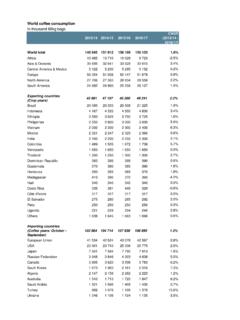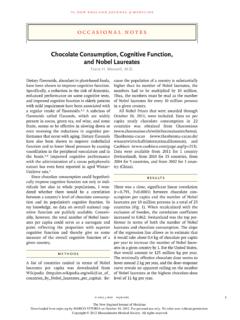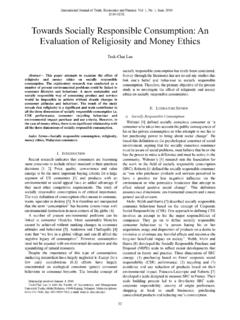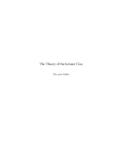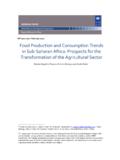Transcription of Liquid Nitrogen Consumption in Cryogenic Freezers 2
1 1 Liquid Nitrogen Consumption in Cryogenic Freezers As more research workers realize the desirability of storing biologicals in Cryogenic temperatures, larger, dry Freezers are newly appearing. It is my experience that the physics and mechanics of refrigeration are not high on the list of things that interest bio-researchers until something appears to be wrong. It is not a frequent event that anything is actually wrong with a large vapor phase Liquid Nitrogen freezer other than they are different from the smaller Dewar-style Freezers that have traditionally been in labs. Why are these new vapor-phase Freezers appearing in such numbers recently?
2 There are at least 3 reasons I have found for this proliferation: 1. Lab floor space is ever harder to come by, and multiple small Freezers are being consolidated into larger central Freezers . This is a more efficient use of valuable space. 2. Biologicals can continue to break down in the warmer temperatures of 80 C ultralow and 20 C standard Freezers . When in doubt, use Cryogenic storage to insure stability. 3. Old style, in- Liquid Freezers have conclusively been shown to be vectors of contamination transfer between samples. While it is possible to hold samples in vapor using Dewar-style Freezers , it is far more difficult to manage the Liquid level to avoid accidental Liquid submersion.
3 {Q} So, what is there to complain about with these large Freezers that can hold tens of thousands of samples? {A} They use more Nitrogen than small Dewar-style Freezers , even though they are working as designed and anticipated. Well, why is this expected? Simply, the extra Nitrogen is lost because of the size of the freezer and the convenience of access to the inventory. Most of the Static, or Inherent , Nitrogen Loss in any Cryogenic freezer is through the top (see the index piece from the folks at for the construction and characteristics of Thermos). Traditionally, the Dewar-style Freezers had very small openings (2 or ) and top plugs to minimize heat gain.
4 This design, however, severely limits the number of samples contained because the rack has to hang from the lip and be able to fit through the opening. Currently, the upper capacity for these Dewar-style Freezers is around 6000 x 2 ml samples with a 8-1/2 neck opening. This freezer has a top opening large enough to fit racks holding 10 standard 2 boxes that can hold 100 samples each. The best fit has only 6 racks. Once you want more racks in the freezer the top gets larger and more heat enters (to burn off Liquid Nitrogen ). When you want more racks in the freezer it becomes a better design to have the racks sitting on the bottom.
5 If the racks sit on the bottom the opening has to be large enough to easily access them for removal. You can see where this goes; the opening gets bigger as the capacity increases and the static losses increase. Unfortunately, there is more. As more people use the freezer even more Nitrogen is lost because the top is opened and samples added/removed. This is the In-Use Nitrogen Loss that cannot be calculated prior to operating the freezer in any given lab situation. Then there is the Fill or Transfer Nitrogen Loss that must occur every time the freezer is refilled with Liquid Nitrogen from a source tank.
6 All that hardware between the interior of the source tank and the interior of the freezer will boil away Nitrogen until it is cooled down from room temperature (+21 C) to Liquid Nitrogen temperature (-196 C). 2 Remember, also, that the source tank also has a static loss of some - 6 liters per day just sitting there. And that 180-liter source tank you paid for; well, it probably didn t arrive with 180 liters. More likely, it had less because of the way the supplier fills, stores, and transports These 4 types of losses are common to all Freezers whether large or small. It is just a characteristic that the larger the freezer the larger the losses.
7 So let s do a calculation for a CBS V-3000 Isothermal freezer that can hold more than 22,000 x 2ml sample vials. 1. Static loss of 9 liters per day 2. Use loss; it s up to you, 0-8 liters per day maybe 3. Transfer loss of 3-6 liters per event (try to make the hose as short as possible and only fill when really needed, such as every other day) 4. Source cylinder static loss of liters per day (generally, better on new equipment, worse on old) This works out to 12 liters, and up to 29 liters, per day depending on usage and condition of equipment, (or 6 days of use from the source tank for worst conditions to about 15 days at best with, reasonable, 12-14 days expected).
8 Cryogenic freezer Design Options These Freezers are both from Custom Biogenic Systems. Why would you prefer one to the other? Both have microcircuit control of Liquid level and alarms. The big beast on the right (model 850) actually has about twice the capacity for 2 ml vials that the V-3000 has (larger of the 2 in the left picture) and it consumes less Liquid Nitrogen by static loss. The model 850 is an old style freezer that has Liquid Nitrogen in the sample chamber. Originally built to be filled with Nitrogen for Liquid phase storage, to run it as a vapor phase unit there has to be at least 6 inches of box storage lost at the bottom for the Liquid coolant (this is a common trait for all Freezers other than the CBS Isothermal line).
9 Also, access to the samples is through a round hatch. Retrieving the racks means that there has to be a carousel that can be rotated to bring the racks under the opening. Retrieval of some of the 1 I know that this is an incredibly confrontational thing to say, but the freezer manufacturer has done numerous tests to prove it. The gas suppliers will adamantly deny this, and they know you probably have no way of checking them on it. The only acceptable way to prove whether that the tank is actually filled is to weigh it before and after a fill; a very inconvenient procedure for just about every customer.
10 One liter of Liquid Nitrogen weighs pounds, so a 180-liter fill adds 320 pounds to the tank that weighs about 250 pounds. 3racks may require removal of other racks that are blocking. There are certainly times when removing racks while finding others can put samples in danger of warming sufficiently to be harmful to the product. Since there is a considerable distance from the Liquid Nitrogen to the top of the freezer there can be a significant temperature gradient from the cold low level to the warmer upper level. And then, there is the problem of the cloud in the chamber that obscures your view that is a considerable problem in these enclosed Freezers (blowing on the cloud makes it worse BTW).

